Barcelona, Spain & DCDNY Virtual
Last 31st March 2020, Scott Noteboom (CTO of Submer) led a panel at #DCDNYCVirtual, entitled “Exploration into the next generation of immersion-cooled datacenters”.
In his presentation, Scott Noteboom focused on some aspects that explain how the transition to Immersion Cooling is the only possible way to cope with the rising computational densities, offering a solution that is highly-efficient and at the same time kind to the environment.
In this second article (of two), we’ll go through some of the ideas that Scott shared during his presentation.
Today’s Datacenters have run out of Breath
Scott started analysing the current datacenter industry, where datacenters are literally and metaphorically “running out of breath”.
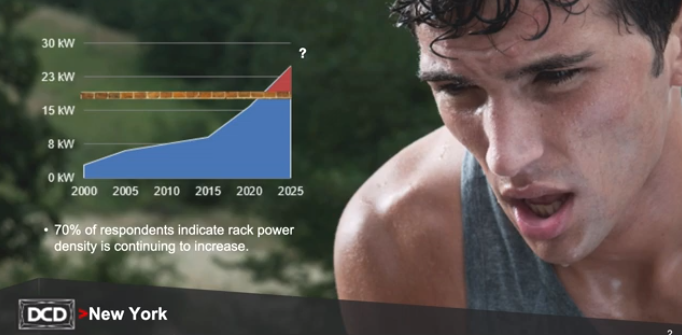
So, the challenge that the industry is facing is: using traditional air-cooling methods is clearly not a viable solution to cool racks which density is getting denser and denser. So do we efficiently cool a 100 kW (or even more) per rack? According to Scott, the answer lies in our own biology…
One of the strongest and most innovative ideas of Scott is the association of computers and datacenters to living bodies. To Scott, a computer is basically like a human brain, and just like a human brain, it works better in a fluid environment. And one of the most provoking questions that Scott poses is: we as humans need air for our survival… Do computers (and datacenters) need air as well? Very unlikely…
The answers lie inside our own biology…
(Scott Noteboom, CTO of Submer)
The Human HVAC System
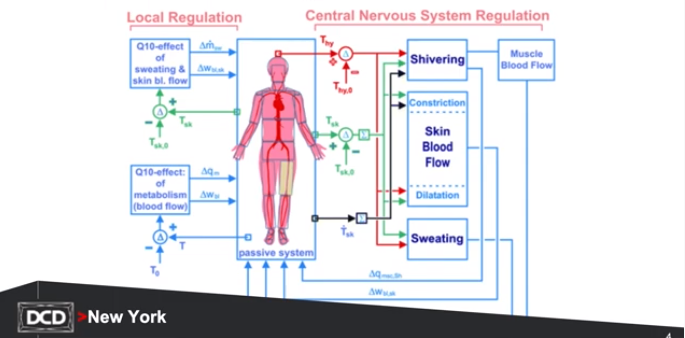
The human body as a datacenter, according to Scott’s interpretation.
Continuing his parallelism between brain and computers, Scott pointed out that the human brain never lived in an air-cooled environment. And that was due to five different reasons very similar to the criteria that drive any datacenter:
- Performance
- Density
- Efficiency
- Resiliency
- Reliability
This also explains how, even though computers are approaching the capabilities of a single human mind, our brains remain more efficient than any computer.
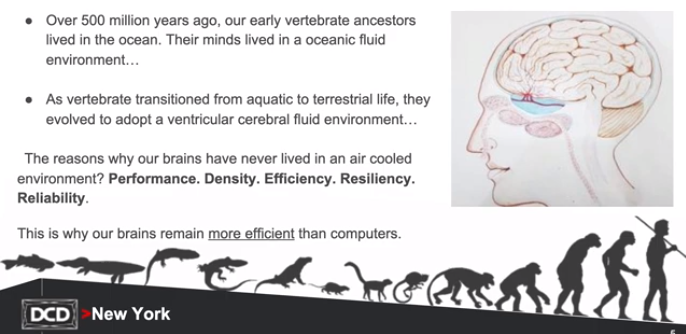
Evolution from ocean water to cerebral fluid
In the body of most any being that has intelligence, there is fluid. Biology shows us that a dielectric fluid environment is optimal for computing and computing communications in the mind.
“I think the answers are inside of us right now and I think nature or God or whatever you want to call figured a lot of things […] that apply not only to our computer inside our brain, but that could be applied to the computer in the data set.”
(Scott Noteboom, CTO of Submer)
The real question is then: is that 99% of the industry prepared to face a future where, due to density skyrocketing, air-cooling will not be enough to cool IT components?
If we follow the evolution paradigm of humanity, it is very likely that the 1% will gradually become a 10%, and then a 20%, and then a 30%, and so on.
How Immersion Cooling can Help Increasing Compute Capacity and Space Density
Average power density has gone from 4-5kW (about 10 years ago) to 7-10kW, according to AFCOM. According to Uptime Institute, “back in 2012, the highest density racks the organization could find were consuming 26kW. Last year, ten percent of respondents to its data centre survey reported that they were running some of their racks at above 40kW”.
Let’s take in consideration a GPU: a GPU has many fans and as you get into more advanced GPUs, the motherboard and the chassis itself are really designed as a big air plenum, or an air handler for airflow to go across it, otherwise, it would not work.
So what if you would have to worry about the airflow for cooling your IT equipment?
Some of the most immediate benefits would be:
- More computational density
- Less physical space occupied
- More stable temperature environment (and consequently a lower IT failure rate)
- Longer IT life-span
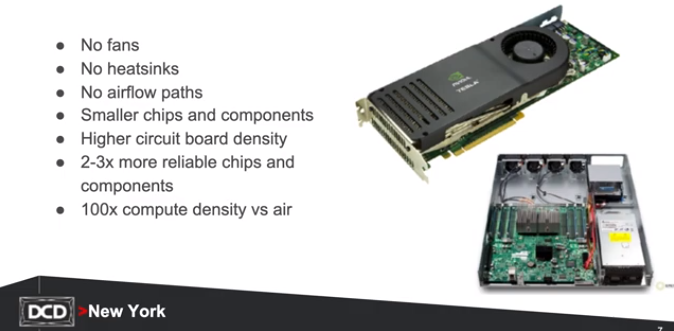
So the change we are talking about here doesn’t not only refer to the cooling system. Because given the circumstances described above, what we are witnessing is a deep change in the computing (and as a consequence in the datacenter industry) paradigm. It is highly probable that in a not so distant future, we will have a computer chassis as small as an iPhone, delivering a computational density that now is only imaginable. And that super small, super-dense chassis will be very likely – we’d say almost logically – liquid-cooled.
Increased Power Density in Fluid
When you look at the next generation kind of energy grid type solutions, and in particular to the next generation battery solutions related to energy, most of the innovation is all happening in the electric car space.
In the picture below, you see a lithium-ion battery pack from a company called Xing Mobility (from Taiwan).
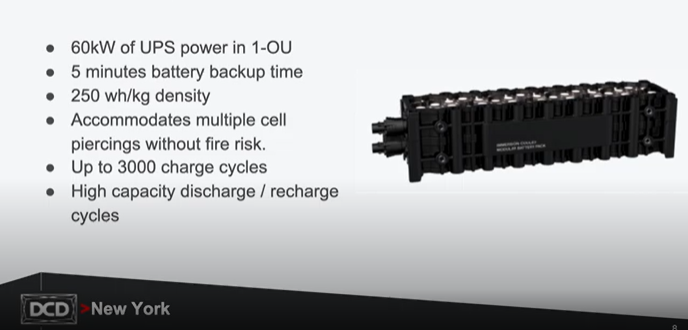
In the electric car industry, everyone has been looking at the emerging cooled battery environment for the exact same reason we have in computing: reaching more density of power (and being able to efficiently cool it).
The Importance of the “Cerebral Fluid”
How does this cerebral fluid affect us in the datacenter industry?”, asks Scott. Well, first of all, it affects datacenter design.
Datacenter Design – Flexible Cooling
The datacenter industry accomplished its goal in terms of modularity for speed of construction and scalability, and it successfully managed to keep up with the growth of the cloud. What the industry has not accomplished yet, it’s to get modularity for flexibility of service.
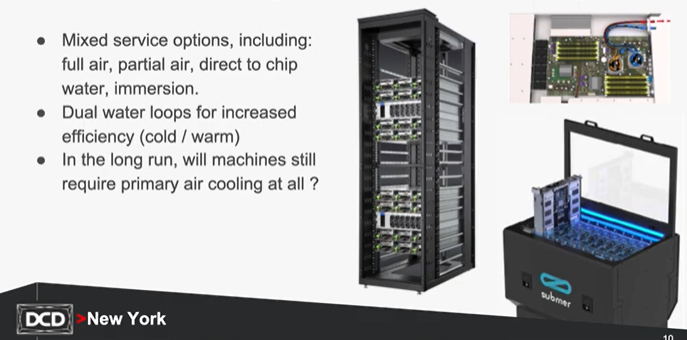
Datacenter Design – Flexible Power
In this slide, Scott describes the flexible power approach in datacenter designing to increase compute utilization of servers and manage any cooling and space issue, by automatically and quickly shifting loads.
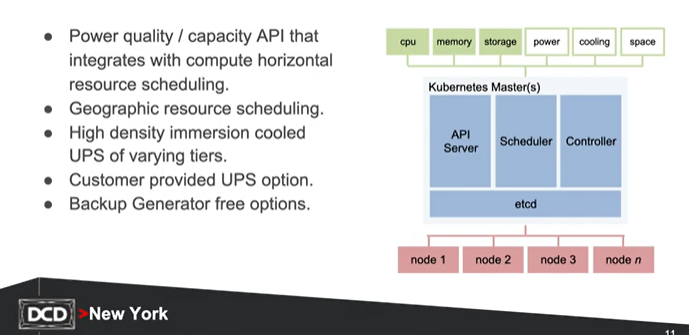
Datacenter Design – Flexible Space
The robotic environment enables the emergent “cerebral fluid environment” to connect with the outsider world, just like (continuing with human body metaphor), lungs connect the human brain to the blood system.
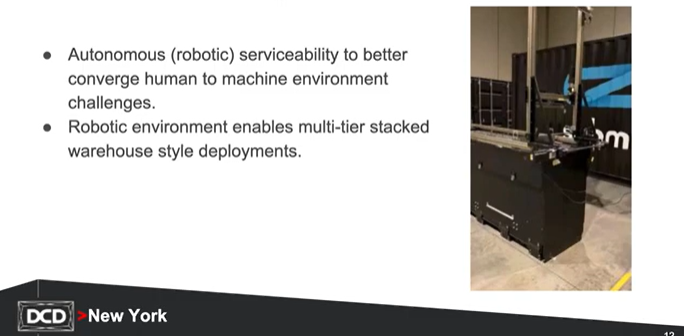
Summary
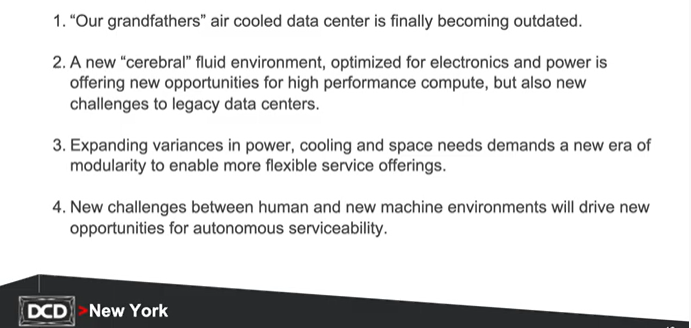
Scott’s was among the most successful presentations of the whole #DCDNYCVirtual. We just wanted to give all of you the opportunity of seeing it, in case you missed. Here is the link to our YouTube Channel.

